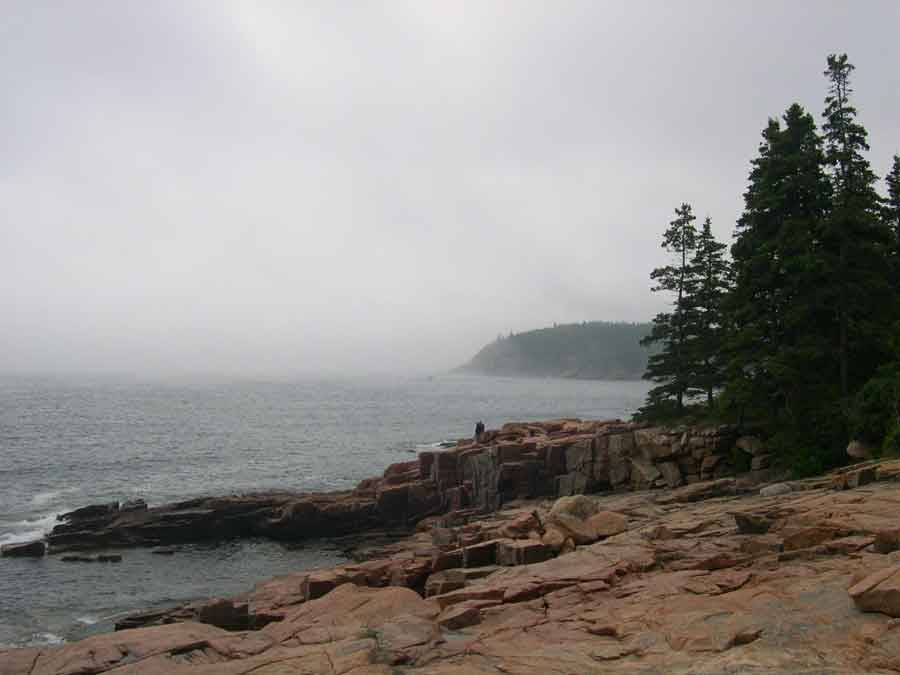
The Park Loop Road navigates the park’s features.
The Precipice Trail is a highlight. Peregrine falcons have nested here since 1991. Several pair nest in the park, but these are usually the most visible. Rangers and docents are stationed below the peak to point out the locations of the falcons. During the nesting season, the trail is closed. When the trail reopens in mid-August, it offers a spectacular climb to the summit of Champlain Mountain. In several places, iron ladders hammered into the cliff assist the hiker over vertical passes. Though this sounds challenging, kids and adults alike enjoy the climb. The view from the top is spectacular. The ascent takes most people about an hour.
Sand Beach is a fun stroll in any season. Its pure southern exposure has created a small sand beach that is rare north of Portland. It is sheltered from prevailing breezes and faces into the sunlight so that sitting in the sand is pleasant even in January. Common eiders, common loons, red-breasted mergansers, buffleheads, and both red-necked and horned grebes should be present in winter. The loons especially favor the left shoreline. Red-throated loons and harlequin ducks appear here occasionally.
The walking path from Sand Beach to Thunder Hole to Otter Cliffs showcases black-capped chickadees and golden-crowned kinglets in any season. Common eiders are present year round, though their numbers swell in winter. A scan of the water in winter usually reveals black guillemots, red-breasted mergansers, horned grebes and possibly red-necked grebes. In winter, great cormorants replace double-crested cormorants and their white cheeks and wing patches should be evident as they fly by. From late summer well into December, northern gannets can often be seen in the distance. The rocks along this section of the coast are an excellent place to look for purple sandpipers in winter. Peeps on the wing in winter are almost certainly these. However, when they are roosting motionless on rocks, or feeding quietly, they are surprisingly easy to overlook. Their coloration blends with the quartz-laden granite, making them appear as innocuous bumps or vegetation on the rocks.
Thunder Hole is one of Acadia’s top attractions. At times, the surf crashes into the natural grotto with explosive force. However, it requires the right combination of tide and wind to get the full effect. It’s a great place to scan for sea ducks and harbor seals.
Otter Cliff lies just beyond a gate that is closed in winter. The cliff is panoramic but, despite the name, there are no sea otters. A bell buoy offshore marks a rock reef that is visible at low tide. In winter, great cormorants are a good bet, sometimes roosting on the bell. Continue around the bend and down to Otter Point. The woods in this area are full of golden-crowned kinglets, black-capped chickadees, and red-breasted nuthatches. A short path leads to Otter Point and it’s worth another scan, especially along the rocks, for wintering purple sandpipers. Continue around the corner and downhill to the Fabri Picnic Area. This was the site of an early World War I radio communications facility that was, at the time, the most advanced in the world. Scan the inlet from this vantage point for more common loons and red-breasted mergansers. In breeding season, this is a particularly good spot for warbler variety.
At the bottom of the inlet, the Park Loop Road makes a deep U-turn over a causeway that carries water in and out of a tidal pond. Buffleheads and American black ducks are likely in the offseason. Continuing back up the hill on the far side of the cove, there are more scenic overlooks. It is not marked, but Acadia’s Blackwoods Campground is in the woods behind the loop road here. Within another mile, the road turns away from the ocean and reenters woods that are normally noisy with black-capped chickadees, red-breasted nuthatches, golden-crowned kinglets and brown creepers.
Most of the Park Loop Road is closed and unplowed in the winter, to the benefit of snowmobilers and cross-country skiers. However, the most popular 2-mile section from the Entrance Station to Otter Cliffs is open and accessible from a winter entrance. Heading south from Bar Harbor on Route 3, note the ball fields on the right. In about .7 miles, the road forks. Bearing left leads to the winter entrance. For 2.5 miles the road advances through birch and aspen groves, and frozen marshes impounded by beavers. At the T intersection, a left turn leads to a scenic overlook parking lot. The trail to seaside is paved, but is often icy in winter. A right turn leads to the Entrance Station. There is no entry fee from November through April. The winter exit from the Park Loop Road bears right just before Otter Cliff and returns to Route 3.
25 Visitor Center Rd
Bar Harbor, ME 04609

